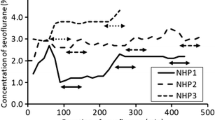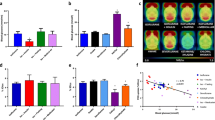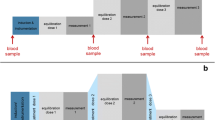Abstract
Rationale
Caffeine is a widely studied psychostimulant, even though its exact effect on brain activity remains to be elucidated. Positron emission tomography (PET) allows studying mechanisms underlying cerebral metabolic responses to caffeine in caffeine-naïve rats. Rodent studies are typically performed under anesthesia. However, the anesthesia may affect neurotransmitter systems targeted by tested drugs.
Objectives
The scope of the present study was to address the impairing or enhancing effect of two common anesthetics, alpha-chloralose and isoflurane, on the kinetics of caffeine.
Methods
The first group of rats (n = 15) were anesthetized under 1.5% isoflurane anesthesia. The second group of rats (n = 15) were anesthetized under alpha-chloralose (80 mg/kg). These rats received an intravenous injection of saline (n = 5) or of 2.5 mg/kg (n = 5) or 40 mg/kg (n = 5) caffeine for both groups.
Results
With 2.5 mg/kg or 40 mg/kg caffeine, whole-brain cerebral metabolism was significantly reduced by 17.2% and 17% (both P < 0.01), respectively, under alpha-chloralose anesthesia. However, the lower dose of caffeine (2.5 mg/kg) had a limited effect on brain metabolism, whereas its higher dose (40 mg/kg) produced enhancements in brain metabolism in the striatum, hippocampus, and thalamus (all P < 0.05) under isoflurane anesthesia.
Conclusion
These findings demonstrate significant differences in brain responses to caffeine on the basic of the anesthesia regimen used, which highlights the importance of attention to the anesthetic used when interpreting findings from animal pharmacological studies because of possible interactions between the anesthetic and the drug under study.



Similar content being viewed by others
References
Acquas E, Tanda G, Di Chiara G (2002) Differential effects of caffeine on dopamine and acetylcholine transmission in brain areas of drug-naive and caffeine-pretreated rats. Neuropsychopharmacology 27:182–193
Antunes LM, Golledge HD, Roughan JV, Flecknell PA (2003a) Comparison of electroencephalogram activity and auditory evoked responses during isoflurane and halothane anaesthesia in the rat. Vet Anaesth Analg 30:15–23
Antunes LM, Roughan JV, Flecknell PA (2003b) Effects of different propofol infusion rates on EEG activity and AEP responses in rats. J Vet Pharmacol Ther 26:369–376
Antunes LM, Roughan JV, Flecknell PA (2003c) Excitatory effects of fentanyl upon the rat electroencephalogram and auditory-evoked potential responses during anaesthesia. Eur J Anaesthesiol 20:800–808
Azdad K, Gall D, Woods AS, Ledent C, Ferre S, Schiffmann SN (2009) Dopamine D2 and adenosine A2A receptors regulate NMDA-mediated excitation in accumbens neurons through A2A-D2 receptor heteromerization. Neuropsychopharmacology 34:972–986
Benveniste H, Fowler JS, Rooney WD, Scharf BA, Backus WW, Izrailtyan I, Knudsen GM, Hasselbalch SG, Volkow ND (2010) Cocaine is pharmacologically active in the nonhuman primate fetal brain. Proc Natl Acad Sci U S A 107:1582–1587
Berkowitz BA, Spector S (1971) The effect of caffeine and theophylline on the disposition of brain serotonin in the rat. Eur J Pharmacol 16:322–325
Berkowitz BA, Tarver JH, Spector S (1970) Release of norepinephrine in the central nervous system by theophylline and caffeine. Eur J Pharmacol 10:64–71
Buzsaki G, Kaila K, Raichle M (2007) Inhibition and brain work. Neuron 56:771–783
Cannella N, Cosa-Linan A, Roscher M, Takahashi TT, Vogler N, Wangler B, Spanagel R (2017) [18F]-Fluorodeoxyglucose-positron emission tomography in rats with prolonged cocaine self-administration suggests potential brain biomarkers for addictive behavior. Frontiers in psychiatry 8:218
Chung YH, Hsu PH, Huang CW, Hsieh WC, Huang FT, Chang WC, Chiu H, Hsu ST, Yen TC (2014) Evaluation of prognostic integrin alpha2beta1 PET tracer and concurrent targeting delivery using focused ultrasound for brain glioma detection. Mol Pharm 11:3904–3914
Dager SR, Layton ME, Strauss W, Richards TL, Heide A, Friedman SD, Artru AA, Hayes CE, Posse S (1999) Human brain metabolic response to caffeine and the effects of tolerance. Am J Psychiatry 156:229–237
Dews PB, O'Brien CP, Bergman J (2002) Caffeine: behavioral effects of withdrawal and related issues. Food Chem Toxicol 40:1257–1261
Dunwiddie TV, Masino SA (2001) The role and regulation of adenosine in the central nervous system. Annu Rev Neurosci 24:31–55
Ferre S (2010) Role of the central ascending neurotransmitter systems in the psychostimulant effects of caffeine. J Alzheimer's Dis : JAD 20(Suppl 1):S35–S49
Fredholm BB, Battig K, Holmen J, Nehlig A, Zvartau EE (1999) Actions of caffeine in the brain with special reference to factors that contribute to its widespread use. Pharmacol Rev 51:83–133
Fukumitsu N, Ishii K, Kimura Y, Oda K, Sasaki T, Mori Y, Ishiwata K (2003) Imaging of adenosine A1 receptors in the human brain by positron emission tomography with [11C]MPDX. Ann Nucl Med 17:511–515
Garrett KM, Gan J (1998) Enhancement of gamma-aminobutyric acidA receptor activity by alpha-chloralose. J Pharmacol Exp Ther 285:680–686
Griffeth VE, Perthen JE, Buxton RB (2011) Prospects for quantitative fMRI: investigating the effects of caffeine on baseline oxygen metabolism and the response to a visual stimulus in humans. NeuroImage 57:809–816
Hendrich KS, Kochanek PM, Melick JA, Schiding JK, Statler KD, Williams DS, Marion DW, Ho C (2001) Cerebral perfusion during anesthesia with fentanyl, isoflurane, or pentobarbital in normal rats studied by arterial spin-labeled MRI. Magn Reson Med 46:202–206
Ishiwata K, Mishina M, Kimura Y, Oda K, Sasaki T, Ishii K (2005) First visualization of adenosine A(2A) receptors in the human brain by positron emission tomography with [11C]TMSX. Synapse 55:133–136
Johansson B, Ahlberg S, van der Ploeg I, Brene S, Lindefors N, Persson H, Fredholm BB (1993) Effect of long term caffeine treatment on A1 and A2 adenosine receptor binding and on mRNA levels in rat brain. Naunyn Schmiedeberg's Arch Pharmacol 347:407–414
Keita H, Henzel-Rouelle D, Dupont H, Desmonts JM, Mantz J (1999) Halothane and isoflurane increase spontaneous but reduce the N-methyl-D-aspartate-evoked dopamine release in rat striatal slices: evidence for direct presynaptic effects. Anesthesiology 91:1788–1797
Laurienti PJ, Field AS, Burdette JH, Maldjian JA, Yen YF, Moody DM (2002) Dietary caffeine consumption modulates fMRI measures. NeuroImage 17:751–757
Lee HB, Blaufox MD (1985) Blood volume in the rat. J Nucl Med 26:72–76
Leoni RF, Paiva FF, Henning EC, Nascimento GC, Tannus A, de Araujo DB, Silva AC (2011) Magnetic resonance imaging quantification of regional cerebral blood flow and cerebrovascular reactivity to carbon dioxide in normotensive and hypertensive rats. NeuroImage 58:75–81
Lindauer U, Villringer A, Dirnagl U (1993) Characterization of CBF response to somatosensory stimulation: model and influence of anesthetics. Am J Phys 264:H1223–H1228
Logothetis NK (2008) What we can do and what we cannot do with fMRI. Nature 453:869–878
Low LA, Bauer LC, Klaunberg BA (2016) Comparing the effects of isoflurane and alpha chloralose upon mouse physiology. PLoS One 11:e0154936
Makaryus R, Lee H, Yu M, Zhang S, Smith SD, Rebecchi M, Glass PS, Benveniste H (2011) The metabolomic profile during isoflurane anesthesia differs from propofol anesthesia in the live rodent brain. J Cerebral Blood Flow Metab 31:1432–1442
Masamoto K, Kim T, Fukuda M, Wang P, Kim SG (2007) Relationship between neural, vascular, and BOLD signals in isoflurane-anesthetized rat somatosensory cortex. Cereb Cortex 17:942–950
Merola A, Germuska MA, Warnert EA, Richmond L, Helme D, Khot S, Murphy K, Rogers PJ, Hall JE, Wise RG (2017) Mapping the pharmacological modulation of brain oxygen metabolism: the effects of caffeine on absolute CMRO2 measured using dual calibrated fMRI. NeuroImage 155:331–343
Nakao Y, Itoh Y, Kuang TY, Cook M, Jehle J, Sokoloff L (2001) Effects of anesthesia on functional activation of cerebral blood flow and metabolism. Proc Natl Acad Sci U S A 98:7593–7598
Nehlig A, Boyet S (2000) Dose-response study of caffeine effects on cerebral functional activity with a specific focus on dependence. Brain Res 858:71–77
Nehlig A, Lucignani G, Kadekaro M, Porrino LJ, Sokoloff L (1984) Effects of acute administration of caffeine on local cerebral glucose utilization in the rat. Eur J Pharmacol 101:91–100
Paasonen J, Salo RA, Shatillo A, Forsberg MM, Narvainen J, Huttunen JK, Grohn O (2016) Comparison of seven different anesthesia protocols for nicotine pharmacologic magnetic resonance imaging in rat. Eur Neuropsychopharmacol 26:518–531
Paasonen J, Stenroos P, Salo RA, Kiviniemi V, Grohn O (2018) Functional connectivity under six anesthesia protocols and the awake condition in rat brain. NeuroImage 172:9–20
Park CA, Kang CK, Son YD, Choi EJ, Kim SH, Oh ST, Kim YB, Park CW, Cho ZH (2014) The effects of caffeine ingestion on cortical areas: functional imaging study. Magn Reson Imaging 32:366–371
Savic N, Sciancalepore M (1998) Intracellular calcium stores modulate miniature GABA-mediated synaptic currents in neonatal rat hippocampal neurons. Eur J Neurosci 10:3379–3386
Shi D, Daly JW (1999) Chronic effects of xanthines on levels of central receptors in mice. Cell Mol Neurobiol 19:719–732
Shih YY, Chen CC, Shyu BC, Lin ZJ, Chiang YC, Jaw FS, Chen YY, Chang C (2009) A new scenario for negative functional magnetic resonance imaging signals: endogenous neurotransmission. J Neurosci 29:3036–3044
Shih YY, Chiang YC, Chen JC, Huang CH, Chen YY, Liu RS, Chang C, Jaw FS (2008) Brain nociceptive imaging in rats using (18)f-fluorodeoxyglucose small-animal positron emission tomography. Neuroscience 155:1221–1226
Solinas M, Ferre S, You ZB, Karcz-Kubicha M, Popoli P, Goldberg SR (2002) Caffeine induces dopamine and glutamate release in the shell of the nucleus accumbens. J Neurosci 22:6321–6324
Solt K, Forman SA (2007) Correlating the clinical actions and molecular mechanisms of general anesthetics. Curr Opin Anaesthesiol 20:300–306
Ueki M, Mies G, Hossmann KA (1992) Effect of alpha-chloralose, halothane, pentobarbital and nitrous oxide anesthesia on metabolic coupling in somatosensory cortex of rat. Acta Anaesthesiol Scand 36:318–322
Uftring SJ, Wachtel SR, Chu D, McCandless C, Levin DN, de Wit H (2001) An fMRI study of the effect of amphetamine on brain activity. Neuropsychopharmacology 25:925–935
Vidyasagar R, Greyling A, Draijer R, Corfield DR, Parkes LM (2013) The effect of black tea and caffeine on regional cerebral blood flow measured with arterial spin labeling. J Cereb Blood Flow Metab 33:963–968
Wang Q, Fong R, Mason P, Fox AP, Xie Z (2014) Caffeine accelerates recovery from general anesthesia. J Neurophysiol 111:1331–1340
Williams KA, Magnuson M, Majeed W, LaConte SM, Peltier SJ, Hu X, Keilholz SD (2010) Comparison of alpha-chloralose, medetomidine and isoflurane anesthesia for functional connectivity mapping in the rat. Magn Reson Imaging 28:995–1003
Xu F, Liu P, Pekar JJ, Lu H (2015) Does acute caffeine ingestion alter brain metabolism in young adults? NeuroImage 110:39–47
Funding
This work was funded by Ministry of Science Technology (MOST 105-2314-B-039-044-MY2).
Author information
Authors and Affiliations
Corresponding author
Ethics declarations
All animal experiments were approved by China Medical University Institutional Animal Care and Use Committee and were carried out in accordance with the approved guidelines.
Conflict of interest
The authors declare that there are no competing interests.
Additional information
Publisher’s Note
Springer Nature remains neutral with regard to jurisdictional claims in published maps and institutional affiliations.
Rights and permissions
About this article
Cite this article
Peng, SL., Chiu, H., Wu, CY. et al. The effect of caffeine on cerebral metabolism during alpha-chloralose anesthesia differs from isoflurane anesthesia in the rat brain. Psychopharmacology 236, 1749–1757 (2019). https://doi.org/10.1007/s00213-018-5157-4
Received:
Accepted:
Published:
Issue Date:
DOI: https://doi.org/10.1007/s00213-018-5157-4




